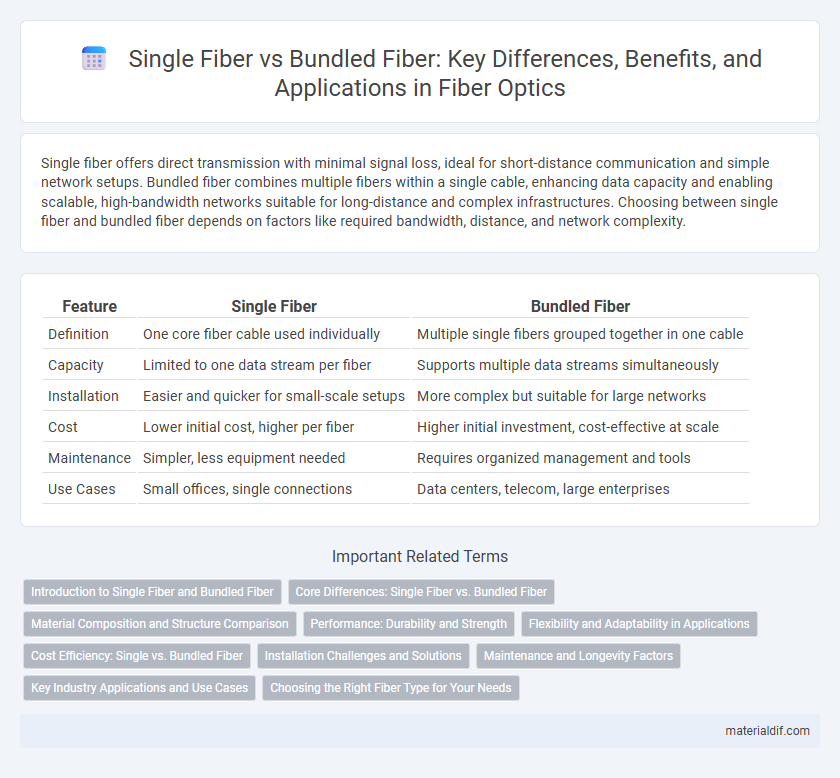Single fiber offers direct transmission with minimal signal loss, ideal for short-distance communication and simple network setups. Bundled fiber combines multiple fibers within a single cable, enhancing data capacity and enabling scalable, high-bandwidth networks suitable for long-distance and complex infrastructures. Choosing between single fiber and bundled fiber depends on factors like required bandwidth, distance, and network complexity.
Table of Comparison
| Feature | Single Fiber | Bundled Fiber |
|---|---|---|
| Definition | One core fiber cable used individually | Multiple single fibers grouped together in one cable |
| Capacity | Limited to one data stream per fiber | Supports multiple data streams simultaneously |
| Installation | Easier and quicker for small-scale setups | More complex but suitable for large networks |
| Cost | Lower initial cost, higher per fiber | Higher initial investment, cost-effective at scale |
| Maintenance | Simpler, less equipment needed | Requires organized management and tools |
| Use Cases | Small offices, single connections | Data centers, telecom, large enterprises |
Introduction to Single Fiber and Bundled Fiber
Single fiber optic cables consist of individual fibers designed for point-to-point communication, offering precise signal transmission and minimal interference. Bundled fiber cables group multiple fibers within a single sheath, enhancing capacity and scalability for large-scale network deployments. Selecting between single and bundled fibers depends on bandwidth requirements, installation environment, and future expansion needs.
Core Differences: Single Fiber vs. Bundled Fiber
Single fiber refers to a single optical fiber strand used for data transmission, offering simplicity and ease of installation in point-to-point communication. Bundled fiber consists of multiple optical fibers grouped together within a single cable, enabling higher data capacity and scalability for complex network infrastructures. The core difference lies in the capacity and application: single fiber suits low-volume, straightforward connections, while bundled fiber supports high-bandwidth, multi-channel communication demands.
Material Composition and Structure Comparison
Single fiber consists of a solitary optical glass core surrounded by a cladding layer, optimized for minimal signal loss and high transmission quality over long distances. Bundled fiber comprises multiple single fibers encased within a protective outer jacket, enabling simultaneous data transmission through numerous channels while offering enhanced durability and flexibility. Material composition in both involves high-purity silica glass cores and polymer cladding, but bundled fiber incorporates additional strength members such as aramid yarn or fiberglass to improve mechanical performance and environmental resistance.
Performance: Durability and Strength
Single fiber optic cables offer focused signal transmission with lower attenuation, but bundled fiber cables enhance overall durability by combining multiple fibers within a protective sheath, reducing the risk of damage and signal loss. Bundled fibers provide superior tensile strength and are better suited for environments with physical stress or frequent handling, ensuring consistent performance over longer periods. Performance optimization in fiber optics depends on the application's demand for flexibility, durability, and signal integrity.
Flexibility and Adaptability in Applications
Single fiber cables offer superior flexibility for precise routing in tight spaces and customized installations, making them ideal for applications requiring frequent adjustments or limited bend radii. Bundled fiber cables provide enhanced adaptability by consolidating multiple fibers into a single sheath, simplifying deployment for large-scale networks and reducing installation time. Choosing between single fiber and bundled fiber depends on the application's need for flexibility in handling versus scalability in fiber count and management.
Cost Efficiency: Single vs. Bundled Fiber
Single fiber optic cables generally offer lower initial installation costs and simpler maintenance due to their straightforward design and ease of handling. Bundled fiber cables, while potentially more expensive upfront, provide cost efficiency in high-demand environments by consolidating multiple fibers into a single installation, reducing space and labor expenses for future expansions. Evaluating total cost of ownership over time shows bundled fiber solutions offer economies of scale, especially in large-scale network deployments.
Installation Challenges and Solutions
Single fiber installation demands precise alignment and protection to prevent signal loss, posing challenges in handling and splicing, especially over long distances. Bundled fiber simplifies network deployment by grouping multiple fibers, reducing installation time, yet requires specialized management to avoid bending and damage to individual fibers within the bundle. Solutions include using advanced fusion splicing technology, adopting protective conduit systems, and implementing robust cable management practices tailored to both single and bundled fiber configurations.
Maintenance and Longevity Factors
Single fiber cables offer easier maintenance due to their simpler structure, reducing the risk of damage during handling and repairs. Bundled fibers, while providing higher capacity, require more complex maintenance procedures to manage individual strands and prevent signal loss. Longevity of single fiber cables benefits from less physical stress, whereas bundled fiber durability depends on protective sheathing quality and proper installation techniques.
Key Industry Applications and Use Cases
Single fiber cables are predominantly used in telecommunications and data centers where precise signal transmission and minimal interference are critical. Bundled fiber cables find extensive application in large-scale infrastructure projects, such as metropolitan area networks (MANs) and campus-wide deployments, providing high-density connectivity with simplified management. Both types support vital industries like healthcare, defense, and finance by enabling scalable, high-speed data transfer and robust network reliability.
Choosing the Right Fiber Type for Your Needs
Single fiber cables offer precise and cost-effective solutions for simple point-to-point connections, making them ideal for short distances and limited data transmission. Bundled fiber cables contain multiple fibers within one sheath, supporting higher bandwidth and scalability for complex networks and long-haul communications. Selecting the right fiber type depends on factors like network size, data load, budget constraints, and future expansion plans.
Single Fiber vs Bundled Fiber Infographic

 materialdif.com
materialdif.com